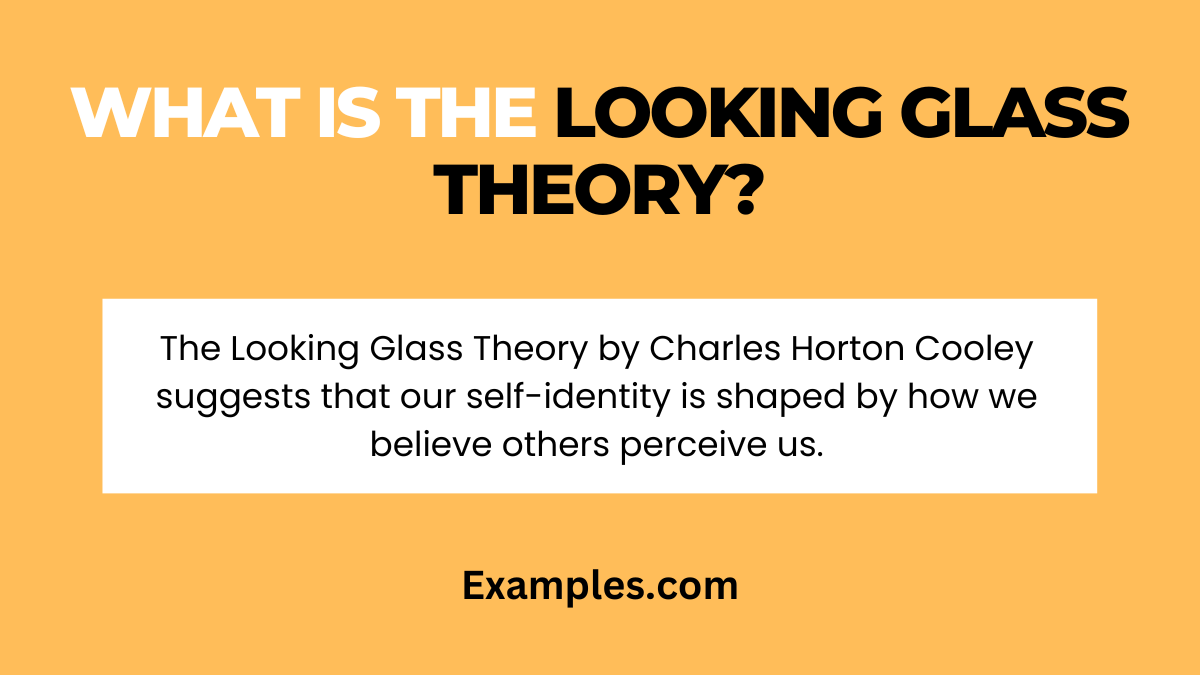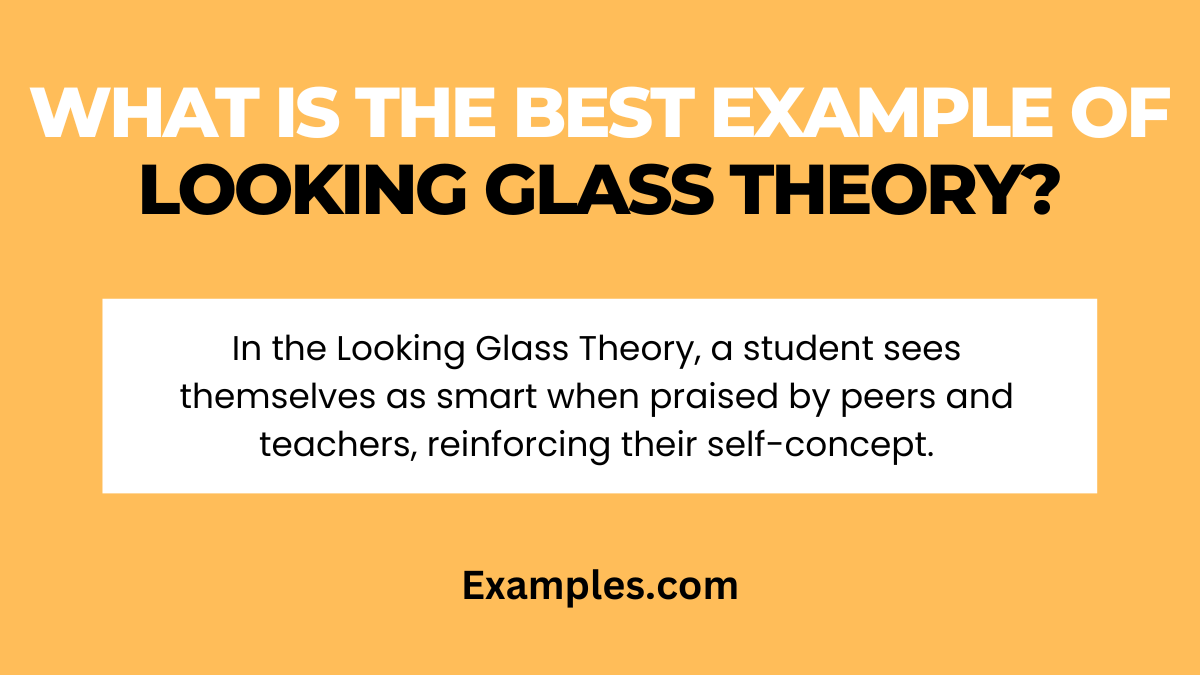19+ Looking Glass Theory Examples
The Looking Glass Theory offers a fascinating insight into how our self-concept is formed and influenced by how we believe others perceive us. This theory, a cornerstone in sociological and psychological studies, suggests that our self-awareness is not just an internal process but also a reflection of the reactions and evaluations of those around us. It emphasizes the importance of interpersonal interactions in shaping our identity. Understanding this theory can unlock new ways of self-improvement and personal development, making it crucial for those interested in psychology, sociology, and personal growth.
What is the Looking Glass Theory?

The Looking Glass Theory, conceptualized by Charles Horton Cooley, is a sociological concept that explains how an individual’s self-identity and self-esteem are influenced by how they perceive others see them. It posits that we form our self-concept based on our understanding of how others view us, leading to a continuous process of self-evaluation and adjustment based on social interactions.
What is the Best Example of Looking Glass Theory?

A classic example of the Looking Glass Theory is a student who perceives themselves as intelligent and competent because their peers and teachers consistently praise their academic abilities. This external validation shapes their self-concept, reinforcing their belief in their intellectual abilities.
History
Who Created: Charles Horton Cooley
Date: 1902
This theory is articulated in his work, “Human Nature and the Social Order.” It represents a pioneering approach to understanding self-concept and identity, particularly focusing on how our self-perception is shaped by our interactions with others
20 Examples of Looking Glass Theory

Looking Glass theory, a psychological concept, emphasizes how an individual’s self-image is shaped by the perceptions and interactions with others. This theory underscores the importance of social interactions in developing one’s sense of self.
- Self-Awareness in Social Settings: Realizing how your behavior changes when you’re aware others are watching. Example: Acting more politely at a formal dinner than when alone.
- Peer Feedback: Adjusting your behavior based on friends’ opinions. Example: Dressing differently after friends comment on your fashion sense.
- Professional Feedback: Altering your work style based on supervisor reviews. Example: Improving communication skills after a performance review highlights this need.
- Family Influence: Your self-perception being influenced by family’s views. Example: Gaining confidence in cooking skills after family compliments.
- Social Media Impact: Changing your online persona based on followers’ reactions. Example: Posting more travel photos after receiving positive feedback.
- Dating and Relationships: Modifying behavior to impress a partner. Example: Trying new hobbies to align with a partner’s interests.
- Classroom Dynamics: Students altering behavior based on teacher’s feedback. Example: Participating more in class discussions after teacher encourages it.
- Sports Team Influence: Adapting athletic performance based on team’s perception. Example: Training harder after teammates express reliance on your performance.
- Workplace Collaboration: Shifting team role based on colleagues’ opinions. Example: Taking on a leadership role after being recognized for organizational skills.
- Cultural Norms and Identity: Shaping personal identity based on cultural expectations. Example: Embracing traditional clothing styles during cultural festivals.
- Children and Parental Feedback: Kids developing self-concept based on parents’ praise or criticism. Example: A child becoming more confident in art after parental encouragement.
- Online Learning Environment: Adjusting study habits based on virtual classmates’ input. Example: Participating more in online forums after positive feedback.
- Public Speaking: Tweaking presentation style based on audience reaction. Example: Using more humor in speeches after audience responds well.
- Community Role: Shaping community involvement based on neighbors’ perceptions. Example: Volunteering more after neighbors express appreciation.
- Personal Branding: Tailoring your personal brand based on audience engagement. Example: Highlighting eco-friendly habits on a blog after reader interest.
- Leadership Styles: Modifying leadership approach based on team feedback. Example: Adopting a more collaborative style after team suggests it.
- Artistic Expression: Artists changing style based on audience reception. Example: Experimenting with new art forms after positive gallery reviews.
- Feedback in Therapy: Adapting self-perception based on therapist’s insights. Example: Working on assertiveness after a therapist points out its lack.
- Academic Performance: Students altering study methods based on teacher’s advice. Example: Focusing more on practical work after teacher suggests it’s a strength.
- Body Image: Influencing body image based on societal beauty standards. Example: Pursuing fitness goals after societal trends favor a certain body type.
Stages of Looking Glass Theory
1. Perception of How We Appear to Others
The first stage involves our perception of how others see us. This is not necessarily a reflection of reality but our interpretation of others’ views.
2. Interpretation of Others’ Reactions
We then interpret how others might react to our appearance and behavior. This interpretation plays a crucial role in forming our self-image.
3. Development of a Self-Concept
Based on these interpretations, we develop a self-concept. This is our understanding of who we are, influenced by perceived reactions from others.
4. Influence on Our Feelings and Attitudes
Our feelings and attitudes towards ourselves are significantly shaped by this self-concept. Positive or negative feedback loops can form, influencing our self-esteem.
5. Continuous Process
The looking glass theory is a continuous process. As we encounter new people and experiences, our self-concept evolves and adapts accordingly.
Who Gave the Looking-Glass Self Theory of Socialization?
1. Charles Horton Cooley
The looking-glass self theory was developed by American sociologist Charles Horton Cooley in the early 20th century.
2. Cooley’s Theory in Social Psychology
Cooley’s theory is a cornerstone in social psychology, emphasizing the social nature of self-development.
3. The Role of Society and Groups
Cooley believed that society and the groups we interact with play a crucial role in the development of our self-concept.
4. Reflection of Others’ Views
According to Cooley, our self-image is a reflection of how we think others perceive us, whether accurately or not.
5. Cooley’s Lasting Impact
Cooley’s work has had a lasting impact on understanding self-concept and socialization, influencing many later theories in sociology and psychology.
How Does the Looking-Glass Self Affect Self-Esteem?
1. Basis in Perceived Judgments
Our self-esteem is heavily influenced by how we believe others perceive us. Positive perceptions can boost self-esteem, while negative ones can diminish it.
2. Feedback Loop
A feedback loop can form where our behavior is influenced by our self-esteem, which in turn is shaped by perceived social reactions.
3. Social Comparison
We often compare ourselves to others based on our interpretations of their views, affecting our self-esteem.
4. Importance of Early Interactions
Early interactions in life, especially during childhood and adolescence, can have a profound impact on self-esteem development.
5. Potential for Distortion
There is a risk of distorting reality, as our perceptions of others’ views may not be accurate, leading to skewed self-esteem.
Looking Glass Theory is essential for effective communication. By following the provided guide and tips, you can write about this theory with clarity and depth. Remember that understanding how others perceive us and using empathy in communication can lead to more meaningful and impactful interactions.



